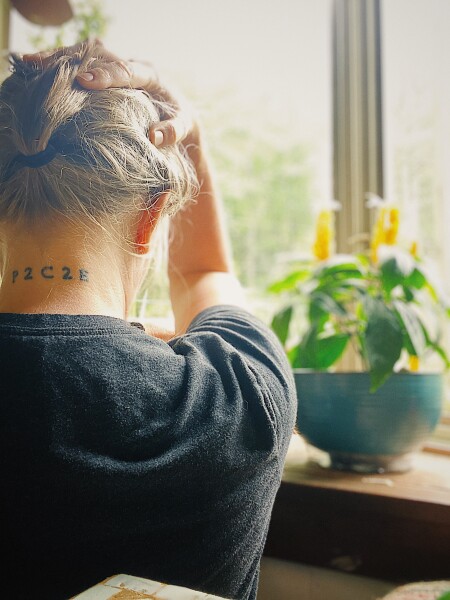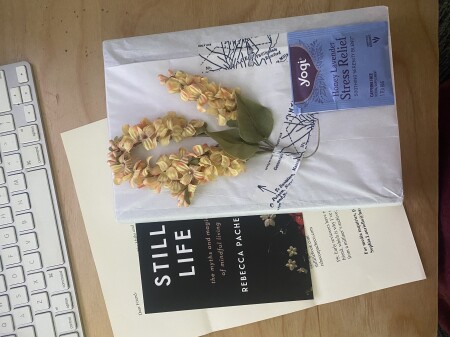
I recently read an op-ed by one of my favorite authors, Salman Rushdie — a man who’s creative mind inspired the tattoo on the back of my neck. (It’s a P2C2E — a process too complicated to explain.)
In What’s irretrievable after a pandemic year, the brilliant and always entirely scientifically pragmatic Rushdie says:
Many people wanted to feel that some good would come out of the horror, that we would as a species somehow learn virtuous lessons and emerge from the cocoon of the lockdown as splendid New Age butterflies and create kinder, gentler, less greedy, more ecologically wise, less racist, less capitalist, more inclusive societies. This seemed to me, still seems to me, like Utopian thinking.
Magical, magical thinking. Rushdie opines, and I would agree, that all that’s come out of this pandemic is division, and maybe less money spent on fancy clothes and lipstick. We’ve realized that both across and even with party lines there are unsurpassable divides. Humanity has been unveiled as, well, pretty terrible.
The science was derided, the administration’s lamentable response to the pandemic was obscured by a blizzard of lies, wearers of masks were abused by wearers of red hats, and the mountain of the dead went on growing.
Okay I’ll stop quoting Rushdie, but read it. Also, I highly recommend two of my other favorite Rushdie books: Midnight’s Children (the Booker of Bookers) and Haroun and the Sea of Stories (the origin of my tattoo).
I feel like we’re all in mourning, realizing that life will never go back to the Before Times, when we were young and innocent and perhaps thought more kindly and generously of each other.
Where I live, in Vermont, we’ve had a pretty good run of it until now. This was mostly because the community-minded mentality of Vermont meant just about everyone wore masks and abided by social distancing guidelines for the duration of the pandemic. We got vaccinated as soon as we could, and those of us that didn’t were carried along by those who did. (You’re welcome.)
At this point, an impressive 68% of Vermonters are fully vaccinated:
While in the US as a whole, we just squeaked into the halfway range:
I am fortunate and grateful to live here, where at least the majority — across party lines — has a scientific, common-sense approach to beating this thing. At the same time, I’ve tried to hold space for those who are “hesitant” because I do agree that the whole thing is frankly terrifying.
Some of us (me) have extreme anxiety about mountain coasters. Others have anxiety about injecting a brand new chemical concoction into their bodies at the urging of the government. I mean, if you put it that way, it makes sense.
But what also makes sense to me is germ theory. My grandfather was a career scientist. My grandmother taught science in the public school system in Concord, MA. My mom studied nutritional science; my dad studied engineering and taught me about the stars. Perhaps I am genetically predisposed to viewing things through a pragmatic scientific lens.
I don’t presume that my point of view is the only way, and I recognize that free will is important. That’s why I sent my kids to Montessori School for three-and-a-half years.
At the end of the day, the lens I view this particular reality through is not a prism, though. It’s a transparent pane of glass, a window into a world where there is a truth:
A deadly virus exists.
That virus has caused a worldwide pandemic, killing 4.26M people and over 600,000 in the U.S. In addition to the “mountain of the dead,” as Rushdie calls it, there have been 35.4M recorded cases in the U.S. (and, practically speaking, probably many more than that) — that’s a lot of really sick, suffering people.
Another truth:
A lot of people worked really hard to come up with a solution — people like Sarah Gilbert, Ugur Sahin, and Ozlem Tureci. The vaccine was rolled out in record time (although here’s a fun story about How New York City Vaccinated 6 Million People in Less Than a Month when smallpox raged in 1947).
Yet another truth:
Vaccines work. That’s why we no longer worry about smallpox, polio, or measles — unless, you know you’re in a community that doesn’t get those vaccines, either. In which case, thanks a lot. And you’re welcome.
Here is a final scientific truth:
With the numbers of vaccinated people still so low nationwide, the virus is still in charge. Because we didn’t tamp it when we could, the virus has now mutated into an even more contagious variant that is now craftily circumventing the barriers. People — even vaccinated people — are getting sick. (Although, again, vaccines still work.)
Like even the best birth control, vaccines are never 100% effective. It was always a given that some vaccinated people would get sick, but it was clear from the beginning that if enough people got vaccinated, we would reach herd immunity and the problem would solve itself.
Instead, we’re dealing with a monster rearing its second head because it wasn’t effectively slayed the first time:
“The death rate from COVID-19 in the U.S. is rising steadily for the first time in months as the nation grapples with a renewed burst of cases in what’s become “a pandemic of the unvaccinated,” the head of the Centers for Disease Control and Prevention said Friday.” — NPR
All along, there’s been great fear, anxiety, mayhem, and sorrow. The sorrow, it’s been mythological.
And to think, all we had to do was work together. All we had to do was get the vaccine, wear our masks, and do the things that viral science dictated would curb this pandemic.
But we didn’t do that. We couldn’t do that. Because a misguided version of “freedom” is more important to Americans than basic humanity.
Is COVID a P2C2E?
Not really. It’s actually quite easy to understand. But the lens has to be clear, and above all it must be humanistic.
. . . . . . . . . . . . . . . . . . . . . . . . . . . . . . . . . . .
What I’m reading:
The Hidden Life of Trees — I had a credit at the local bookstore, Everyone’s Books, and splurged on the illustrated version of this breathtaking book.
The Still Life by Rebecca Pacheco — the book we all need right now.

What I’m listening to:
Loved this SmartLess podcast episode with four of my favorite famous white dudes
What I’m watching:
How Vaccines Work, Japanese animation style
Also, fine, Ted Lasso.
What I’m working on:
Gearing up to take a two-week vacation, which might be killing me.
In the meantime, a few things I’ve written recently for clients…
-
For January Ventures, The 2021 Early Stage Founder Sentiment Report
-
For Tiqets: Zoo Advertising: 7 Tips to Put Your Zoo or Aquarium on the Map

If you’ve heard the terms “microbiome” or “gut health” over the past five years, perhaps you might recognize that we are in the midst of a scientific paradigm shift of epic proportions.
It’s not that germ theory is wrong, rather that it is incomplete. Yes, there are germs out there like SARS-CoV-2 that could wreak havoc on someone’s biology, but it’s becoming increasingly clear through the emerging science of the last decade that the “terrain” where such a germ might land is a better indicator of health and the ability to resist disease.
Antoine Bechamp, a foil to Louis Pasteur and germ theory, was doing studies on identical twins 150+ years ago where exposure to the same pathogen led to different disease expression. Identical pathogens in contact with identical human genomes led to different exhibition because of different terrains accumulated through individual experiences. There are some accounts that, on his deathbed, Pasteur acknowledged the superiority of terrain theory, though this seems somewhat hyperbolic. What cannot be denied is the robust science of the modern day that confirms Bechamp’s theories.
If germ theory makes sense to you as you say it does, then it’s perfectly logical that you would think COVID is “simple.” Only when you begin to consider the incredible complexity of life might you realize that it is anything but. Science is dynamic and cumulative. While you may be “genetically predisposed” to believe the things you do, it’s more likely a function of your conditioning from members of your family that sound like they were firm in their scientific pragmatism. If your hunch about genetics is right, well, the exciting field of epigenetics is showing how genes can be turned on and off depending on environmental factors, again providing support for the importance of the terrain.
Anyway, I appreciate your work and writing and I wonder: as the parent of identical twins, have you ever seen one get sick while the other remained healthy?
Good luck to you out there in this brave new world.
-db
Hi and thank you for this insightful commentary. Epigenetics are fascinating, both to read about and witness firsthand in my daughters. While they don’t often NOT get sick at the same time, unfortunately, one of my daughters has a severe venom allergy that the other does not share. Most fascinatingly, E is left-handed while P is right-handed. So odd!
I very much appreciate the constantly growing and changing nature of science. I am sure some day people will look back and think, “Can you believe they thought that, then?”